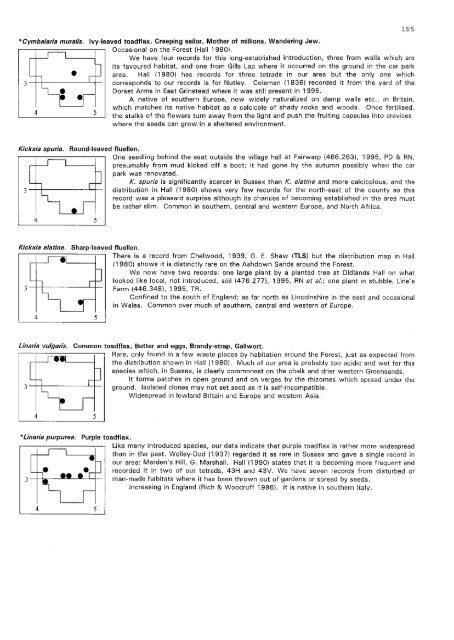Flora of Ashdown Forest - Botanical Society of the British Isles
Flora of Ashdown Forest - Botanical Society of the British Isles
Flora of Ashdown Forest - Botanical Society of the British Isles
Create successful ePaper yourself
Turn your PDF publications into a flip-book with our unique Google optimized e-Paper software.
~'Cymbalaria mural is. Ivy-leaved toadflax, Creeping sailor, Mo<strong>the</strong>r <strong>of</strong> millions, Wandering Jew.Occasional on <strong>the</strong> <strong>Forest</strong> (Hall 1980).We have four records for this long-established introduction, three from walls which areits favoured habitat, and one from Gills Lap where it occurred on <strong>the</strong> ground in <strong>the</strong> car parkarea. Hall (1980) has records for three tetrads in our area but <strong>the</strong> only one which3 --+-+------'--t- corresponds to our records is for Nutley. Coleman (1836) recorded it from <strong>the</strong> yard <strong>of</strong> <strong>the</strong>Dorset Arms in East Grinstead where it was still present in 1995.4 5A native <strong>of</strong> sou<strong>the</strong>rn Europe, now widely naturalized on damp walls etc., in Britain,which matches its native habitat as a calcicole <strong>of</strong> shady rocks and woods. Once fertilised,<strong>the</strong> stalks <strong>of</strong> <strong>the</strong> flowers turn away from <strong>the</strong> light and push <strong>the</strong> fruiting capsules into creviceswhere <strong>the</strong> seeds can grow in a sheltered environment.155Kickxia spuria. Round-leaved fluellen.One seedling behind <strong>the</strong> seat outside <strong>the</strong> village hall at Fairwarp (466.263), 1995, PD & RN,presumably from mud kicked <strong>of</strong>f a boot; it had gone by <strong>the</strong> autumn possibly when <strong>the</strong> carpark was renovated.K. spuria is significantly scarcer in Sussex than K. elatine and more calcicolous, and <strong>the</strong>3 --+-+------'--t- distribution in Hall (1980) shows very few records for <strong>the</strong> north-east <strong>of</strong> <strong>the</strong> county so thisrecord was a pleasant surprise although its chances <strong>of</strong> becoming established in <strong>the</strong> area mustbe ra<strong>the</strong>r slim. Common in sou<strong>the</strong>rn, central and western Europe, and North Africa.4 5Kickxia elatine. Sharp-leaved fluellen.There is a record from Chelwood, 1939, G. E. Shaw (TLS) but <strong>the</strong> distribution map in Hall(1980) shows it is distinctly rare on <strong>the</strong> <strong>Ashdown</strong> Sands around <strong>the</strong> <strong>Forest</strong>.We now have two records: one large plant by a planted tree at Old lands Hall on whatlooked like local, not introduced, soil (476.277), 1995, RN et al.; one plant in stubble, Line's3 Farm (446.348), 1995, TR.Confined to <strong>the</strong> south <strong>of</strong> England; as far north as Lincolnshire in <strong>the</strong> east and occasionalin Wales. Common over much <strong>of</strong> sou<strong>the</strong>rn, central and western <strong>of</strong> Europe.4 5Linaria vulgaris. Common toadflax, Butter and eggs, Brandy-strap, Gallwort.Rare, only found in a few waste places by habitation around <strong>the</strong> <strong>Forest</strong>, just as expected from<strong>the</strong> distribution shown in Hall (1980). Much <strong>of</strong> our area is probably too acidic and wet for thisspecies which, in Sussex, is clearly commonest on <strong>the</strong> chalk and drier western Greensands.It forms patches in open ground and on verges by <strong>the</strong> rhizomes which spread under <strong>the</strong>3 ground. Isolated clones may not set seed as it is self-incompatible.Widespread in lowland Britain and Europe and western Asia.4 5*Linaria purpurea. Purple toadflax.Like many introduced species, our data indicate that purple toadflax is ra<strong>the</strong>r more widespreadthan in <strong>the</strong> past. Wolley-Dod (1937) regarded it as rare in Sussex and gave a single record inour area: Marden's Hill, G. Marshal!. Hall (1980) states that it is becoming more frequent andrecorded it in two <strong>of</strong> our tetrads, 43H and 43V. We have seven records from disturbed or3 man-made habitats where it has been thrown out <strong>of</strong> gardens or spread by seeds.Increasing in England (Rich & Woodruff 1996). It is native in sou<strong>the</strong>rn Italy.4 5
















